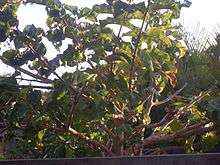Vangueria madagascariensis
| Vangueria madagascariensis | |
|---|---|
 | |
| Scientific classification | |
| Kingdom: | Plantae |
| Clade: | Angiosperms |
| Clade: | Eudicots |
| Clade: | Asterids |
| Order: | Gentianales |
| Family: | Rubiaceae |
| Subfamily: | Ixoroideae |
| Tribe: | Vanguerieae |
| Genus: | Vangueria |
| Species: | V. madagascariensis |
| Binomial name | |
| Vangueria madagascariensis J.F.Gmel. | |
| Synonyms[1] | |
| |
Vangueria madagascariensis, commonly known by the names Spanish-tamarind,[2] tamarind-of-the-Indies,[2] or voa vanga,[3] is a species of flowering plant in the Rubiaceae family native to the African continent having edible fruit.[2] It is the type species of the genus Vangueria and was described in 1791 by Johann Friedrich Gmelin.[4]
Fruit
Vangueria madagascariensis has large, orange fruits that are edible and often consumed locally.
Native distribution
Vangueria madagascariensis is native to Angola, Benin, Cameroon, Central African Republic, the Democratic Republic of the Congo, Ethiopia, Ghana, Kenya, Madagascar, Malawi, Mali, Mozambique, Nigeria, South Africa (in KwaZuluNatal and Transvaal), Sudan, Swaziland, Tanzania (inclusive of the Zanzibar Archipelago) and Uganda.[1]
References
- 1 2 "World Checklist of Rubiaceae". Retrieved 2011. Check date values in:
|access-date=(help) - 1 2 3 GRIN (February 2, 2006). "Information from NPGS/GRIN". Taxonomy for Plants. National Germplasm Resources Laboratory, Beltsville, Maryland: USDA, ARS, National Genetic Resources Program. Retrieved November 4, 2011.
- ↑ "Vangueria madagascariensis". Natural Resources Conservation Service PLANTS Database. USDA. Retrieved 28 July 2015.
- ↑ Linné C von; Beer GE; Gmelin JF (1791). Systema Natura. 2. Leipzig: Impensis Georg Emanuel Beer. p. 367.